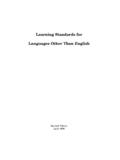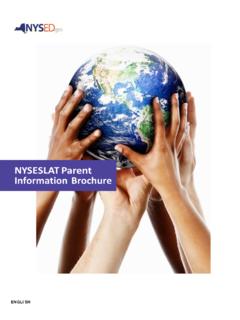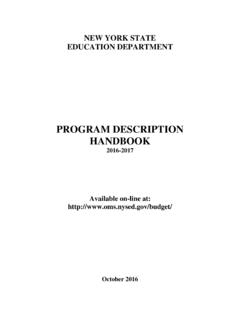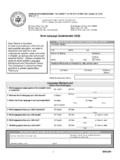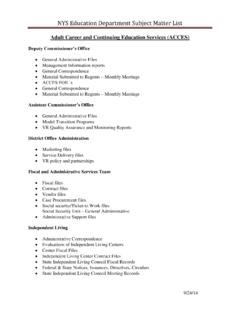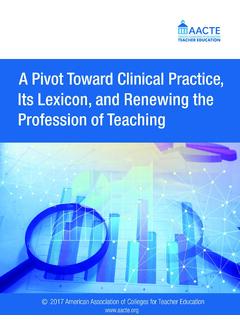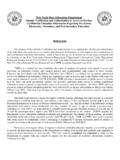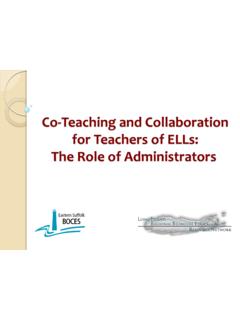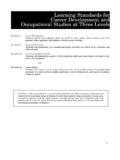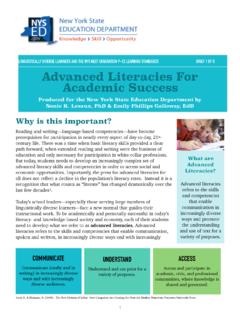Transcription of New York State Next Generation Mathematics Learning …
1 New York State next Generation Mathematics Learning standards 2017 Make sense of problems and persevere in solving them. Reason abstractly and quantitatively. Construct viable arguments and critique the reasoning of others. Use appropriate tools strategically. Look for and make use of structure. Model with Mathematics . Attend to precision. Look for and express regularity in repeated reasoning. Counting and Cardinality Operations and Algebraic Thinking Number and Operations in Base Ten Number and Operations Fractions Ratios and Proportional Relationships The Number System Expressions and Equations Functions Measurement and Data Geometry Statistics and Probability Number and Quantity Algebra Modeling New York State next Generation Mathematics Learning standards (2017)
2 10/2/17 Page | 2 Table of Contents Introduction 3 standards for Mathematical Practice 7 Pre-Kindergarten 10 Kindergarten 17 Grade 1 25 Grade 2 35 Grade 3 45 Grade 4 55 Grade 5 67 Grade 6 77 Grade 7 89 Grade 8 97 High School Introduction 105 Algebra I 108 Geometry 125 Algebra II 139 The Plus (+) standards 157 Works Cited 169 New York State next Generation Mathematics Learning standards (2017) Linked Navigation: Intro, MP, PK, K, 1, 2, 3, 4, 5, 6, 7, 8, HS Intro, Algebra I, Geometry, Algebra II, Plus, Citations Page | 3 Introduction In 2015, New York State (NYS) began a process of review and revision of its current Mathematics standards adopted in January of 2011.
3 Through numerous phases of public comment, virtual and face-to-face meetings with committees consisting of NYS educators (Special Education, Bilingual Education and English as a New Language teachers), parents, curriculum specialists, school administrators, college professors, and experts in cognitive research, the New York State next Generation Mathematics Learning standards (2017) were developed. These revised standards reflect the collaborative efforts and expertise of all constituents involved. The New York State next Generation Mathematics Learning standards (2017) reflect revisions, additions, vertical movement, and clarifications to the current Mathematics standards .
4 The standards are defined as the knowledge, skills and understanding that individuals can and do habitually demonstrate over time because of instruction and Learning experiences. These Mathematics standards , collectively, are focused and cohesive designed to support student access to the knowledge and understanding of the mathematical concepts that are necessary to function in a world very dependent upon the application of Mathematics , while providing educators the opportunity to devise innovative programs to support this endeavor. As with any set of standards , they need to be rigorous; they need to demand a balance of conceptual understanding, procedural fluency and application and represent a significant level of achievement in Mathematics that will enable students to successfully transition to post-secondary education and the workforce.
5 Context for Revision of the NYS next Generation Mathematics Learning standards (2017) Changing expectations for Mathematics achievement Today s children are growing up in a world very different from the one even 15 years ago. Seismic changes in the labor market mean that we are living and working in a knowledge-based economy one that demands advanced literacy and Science, Technology, Engineering and Mathematics (STEM) skills, whether for application in the private or public sector. Today, information moves through media at lightning speeds and is accessible in ways that are unprecedented; technology has eliminated many jobs while changing and creating others, especially those involving mathematical and conceptual reasoning skills.
6 One characteristic of these fast-growing segment of jobs is that the employee needs to be able to solve unstructured problems while working with others in teams. At the same time, migration and immigration rates around the world bring diversity to schools and neighborhoods. The exponential growth in interactions and information sharing from around the world means there is much to process, communicate, analyze and respond to in the everyday, across all settings. For a great majority of jobs, conceptual reasoning and technical writing skills are integral parts to the daily routine. To prepare students for the changes in the way we live and work, and to be sure that our education system keeps pace with what it means to be mathematically literate and what it means to collaboratively problem solve, we need a different approach to daily teaching and Learning .
7 We need content-rich standards that will serve as a platform for advancing children s 21st-century mathematical skills their abstract reasoning, their collaboration skills, their ability to learn from peers and through technology, and their flexibility as a learner in a dynamic Learning environment. Students need to be engaged in dialogue and Learning experiences that allow complex topics and ideas to be explored from many angles and perspectives. They also need to learn how to think and solve problems for which there is no one solution and learn mathematical skills along the way.
8 Increasingly Diverse Learner Populations The need for a deeper, more innovative approach to Mathematics teaching comes at a time when the system is already charged with building up language skills among the increasingly diverse population. Students who are English Language Learners (ELLs)/Multilingual Learners (MLLs) now comprise over 20% of the school-age population, which reflects significant growth in the past several decades. Between 1980 and 2009, this population increased from to million young people, or from 10 to 21% of the school-age population. This growth will likely continue in schools; by 2030, it is anticipated that 40% of the school-age population in the will speak a language other than English at home.
9 (1) Today, in schools and districts across the , many students other than those classified as ELLs are Learning English as an additional language, even if not in the initial stages of language development these children are often described as language minority learners. Likewise, many students, large numbers of whom are growing up in poverty, speak a dialect of English that is different from the academic English found in school curriculum. (2) (3) (4) New York State next Generation Mathematics Learning standards (2017) Linked Navigation: Intro, MP, PK, K, 1, 2, 3, 4, 5, 6, 7, 8, HS Intro, Algebra I, Geometry, Algebra II, Plus, Citations Page | 4 Each of these groups ELLs/MLLs, language minority learners, and students acquiring academic English often struggle to access the language, and therefore the knowledge that fills the pages of academic texts, despite their linguistic assets.
10 Therefore, the context for this new set of Mathematics standards is that there is a pressing need to provide instruction that not only meets, but exceeds standards , as part of system-wide initiative to promote equal access to math skills for all learners while capitalizing on linguistic and cultural diversity. All academic work does, to some degree, involve the academic language needed for success in school. For many students, including ELLs/MLLs, underdeveloped academic language affects their ability to comprehend and analyze texts, limits their ability to write and express their mathematical reasoning effectively, and can hinder their acquisition of academic content in all academic areas in which Learning is demonstrated and assessed through oral and written language.

